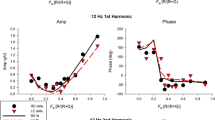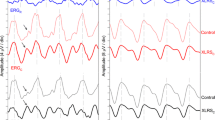Abstract
By means of electroretinographical responses from different areas of the retina (zonular ERGs) both healthy people and patients with central and peripheral retinal degenerations were examined. Responses were registered from three retinal areas (zones): central (red, green, and blue stimuli, 10 ° in diameter, during adaptation of 20 lux); paramacular (a dim, blue, ringlike stimulus, 15 ° inner and 50 ° outer diameter, presented at the beginning of dark adaptation) and peripheral (very dim, blue ring stimulus of a 50 ° inner and 110 ° outer diameter, after 3 min of dark adaptation). The data obtained by this method of stimulation give information about the function of stimulated retinal areas and provide new criteria for the function of the spectrally different photoreceptors responsible for intact color vision. Examples are presented that reveal the value of this method for the detection of congenital color vision defects and for the classification of different types of retinal degeneration. This method is shown to be highly effective and has many advantages over the common routine Ganzfeld ERG technique, especially in cases of unusual retinal degenerations.
Similar content being viewed by others
References
Armington JC (1974) The electroretinogram. New York, Academic Press
Berson EL (1982) Retinitis pigmentosa and allied diseases: applications of electro-retinographic testing. Invest Ophthalmol Vis Sci 4:1–2, 7–22
Brown KT (1968) The electroretinogram: its components and their origin. Vision Res 8:633–677
Brunette JR (1982) Clinical electroretinography. Part 1. Foundation. Can J Ophthalmol 17:143–149
Chatrian GE et al. (1980) Computer-assisted quantitative electroretinography. I. A standardized method. Am J EEG Technol 20:57–77
Marg E (1953) The effect of stimulus size and retinal illuminance on the human electro-retinogram. Am J Optom 30:417–431
Martin DA and Heckenlively JR (1982). The normal electroretinogram. Doc Ophthalmol Proc Ser 31: 135–144
Van Norren D (1982). The technical limitation of clinical electroretinography. Doc Ophthalmol Proc Ser 31:3–12.
Shcherbatova OI, Kaban AA, Bogoslovsky AI, Sokov SL and Vaskov SO (1983) A new method for an objective evaluation of color vision. Vestnik Oftalmologii (in Russian) 5:68–70
Yonemura D and Kawasaki K (1979) New approaches to ophthalmic electrodiagnosis by retinal oscillatory potential, drug-induced responses from retinal pigment epithelium and cone potential. Doc Ophthalmol 8:163–222
Author information
Authors and Affiliations
Rights and permissions
About this article
Cite this article
Trutneva, K.V., Dnestrova, G.I., Shcherbatova, O.I. et al. Electrophysiological estimation of the function of different retinal zones in normal eyes and in retinal degenerations. Doc Ophthalmol 61, 65–69 (1985). https://doi.org/10.1007/BF00143217
Issue Date:
DOI: https://doi.org/10.1007/BF00143217




